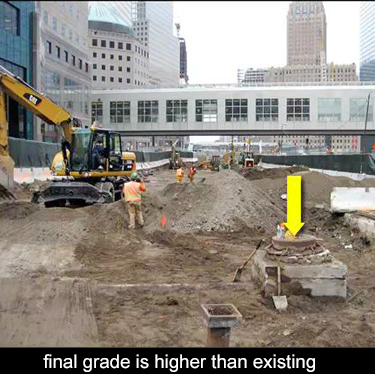Not surprisingly, the very first construction activity is installing a utility - in this case, a sewer. There's rather ingenious means of support of excavation. You're now familiar with various techniques. This technique very closely resembles soldier piles and lagging. At first look, that's what you would take this to be. It's an improvement over the basic system.
This is a ready-made system. These parts are prefabricated. You begin by erecting these elements on the ground, joining them together, and then driving them in place. You must do that because the parts need to fit together. They have to be installed as a unit. Then they become very fast and very effective. This is a very nice approach. It is, I suppose, soldier piles and lagging, but it's a kind of a modernized streamline improved way of doing that.
Here the work has been advanced. All of the piles for the new sewer have been driven. It looks like some kind of a mud slab has been placed to create a good work surface down at the bottom. This work is partially below the water table and ordinary soldier piles and lagging would not give you a water tight enclosure. These side panels are solid.
They're not individual horizontal boards, but they are solid panels, and they fit quite closely together and give you a reasonably watertight trench. Not only is this method an improvement over the traditional soldier piles and lagging, but it also gives you, to some extent, a more watertight enclosure. It was sufficiently watertight to allow you to advance this construction below the water table.
As you drive the H piles and advance the construction, you can add additional panels inside the first panel. Of course, that represents a problem if you have many utilities crossing the trench. These solid panels would not work. That's what gives the traditional soldier piles and lagging their flexibility. The horizontal boards can be fitted around any utility. In this case, you couldn't do that. Of course, you could substitute horizontal boards in place of one of these panels, if you had an occasional utility
 Here, the sewer is complete. it's being backfilled. Also, the area is being raised to grade. You can see from this manhole cover, the new grade is substantially higher than the existing. Now the utilities are out of your way, and you're ready to proceed with the paving. The paving is the most straightforward part of the work. It's easier to predict how long that will take. The utilities are generally much more problematic and they become your critical path.
Here, the sewer is complete. it's being backfilled. Also, the area is being raised to grade. You can see from this manhole cover, the new grade is substantially higher than the existing. Now the utilities are out of your way, and you're ready to proceed with the paving. The paving is the most straightforward part of the work. It's easier to predict how long that will take. The utilities are generally much more problematic and they become your critical path.